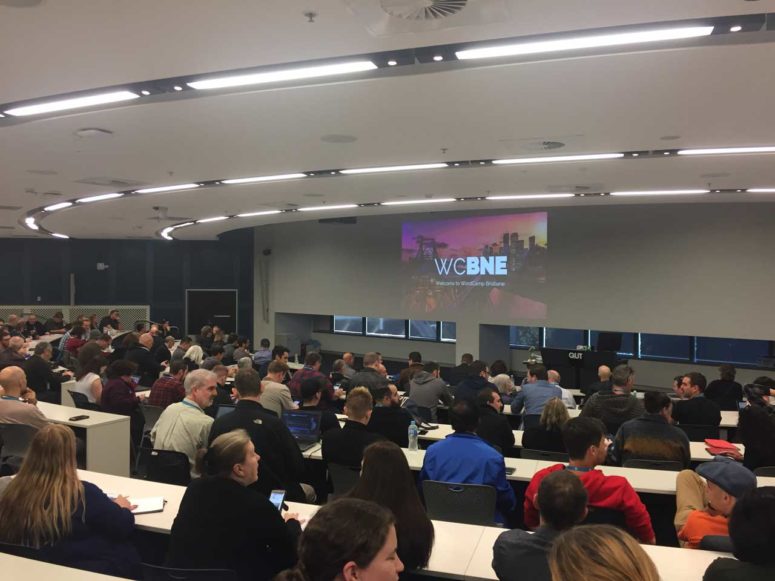WordCamp is a conference that focuses on everything WordPress. WordCamp conferences are community-organized events that caters from casual users to WordPress core developers. Everyone gets together to share ideas, and get to know each other.
If you are a fan of WordPress, and have never been to a WordCamp before, then you should seriously look to consider checking out this awesome event. WordCamp has become a regular event for Australia with a number of regular WordCamps being across most states.
The quality of the presenters and presentations leave the audience wanting more.
Our Web3 team regularly attend, help organise and present at WordCamp events across Australia. We have written about our experiences in the following sections:
WordCamp Melbourne
Not only did both myself and Joseph have the pleasure of attending the Melbourne edition in April 2013, but I was also selected to be a key speaker at the event. My slides and presentation is below.
After touching down in Melbourne on Friday afternoon, I met up with the event organisers and presenters for the inaugural speaker’s dinner. I was immediately taken aback by the passion and enthusiasm of both the speakers and organisers alike.

Next morning, I trammed my way over to the very cool Storey Hall at RMIT University. The venue was packed with a sell-out crowd of over 300 people, and as I settled into the Developer and High Tech streams it became clear to me why WordCamp is the go-to event for WordPress enthusiasts around the world.
Here, I watched Troy Dean deliver a phenomenal presentation on ‘101 Ways to Elevate Yourself and Demand Higher Fees’, followed by a highly informative session by Dan Petrovic on ‘Ten Ways to Screw up With Google and 10 Ways to Fix it’.
Speakers continued to raise the educational bar throughout the conference, as did the amount of enthusiastic avid developers, designers and fans who had united under one roof on a weekend to share their passion for WordPress.
All in all, a brilliant event and an absolute must-attend for anyone working with blogs or building with WordPress.
For our local readers in Brisbane, rumour has it that the next WordCamp Australia will be held in Brisbane early next year! To keep up to date with the latest news on WordCamp in Australia, check out wpaustralia.org and WordCamp Central or follow us on Twitter
Here’s my presentation on Mobile First & Responsive Website Design for WordPress:
WordCamp Sydney
WordCamp Sydney is Sydneys biggest WordPress event. The conference is held at University of Technology Sydney (UTS). Tickets sell out fast.
Official Website: https://sydney.wordcamp.org
Location: UTS, Sydney
James Banks presented at WordCamp Sydney about how to speed up your WordPress Website. Its nice to know that after all these years, the content presented is relevant now more than ever. You can download the free Speed up WordPress ebook here.
WordCamp Brisbane
WordCamp Brisbane is usually held annually in Brisbane City. Tickets sell out fast.
Official Website: https://brisbane.wordcamp.org
Location: QUT Gardens Point, Brisbane
WordCamp Brisbane 2017
Jame Banks presented WordCamp 2017 speaking about how Web3 scaled From One To Many team members on the agency team. He also shared how other WordPress agencies can do the same.
Here’s the slide deck of his presentation:
Resources:
- DOCAS Task Audit Template
- RescueTime
- An Illustrated Guide to Organizational Structures [Free Ebook]
- Hubspot CRM & Zoho CRM
- General WordPress Project Trello board template
- Web3 Prequalification Form
WordCamp Brisbane 2015
It goes without saying that Brisbane’s first WordCamp was a smash hit. The completely sold out event provided excellent content from experts on web design, development, mobile, business, marketing, management and of course, WordPress.
If you didn’t make it, here’s my key take-aways from the presentations that I saw.

Recurring Revenue is the Holy Grail
by Troy Dean
The opening keynote, presented by WordPress and web veteran, Troy Dean, was all about recurring revenue. That is, why you should offer a recurring revenue product or service in your business, and how to do it.
Why your business should offer a recurring revenue product or service:
- We are living in a subscription economy: Food, Consumer Products, Entertainment, Life Organisation
- Here’s what the benefits are of recurring revenue: being able to plan for growth, you can make money in your sleep, creates loyal customers, steady income & cash flow, allows you to be location independent, you can impact more people & the model can work with any business.
How to create a service or product by following the 5 P’s for recurring revenue:
P1 – People
- Which clients are the most likely to repeatably buy something from you?
- Email/call your existing customers and talk to them about it
- Create a basic landing page pre-selling your service/product and send it to your list
- Create a perfect recurring revenue client avatar:
- Check out Duck Tape Marketing for details.
- Check out HubSpot free buyer persona resource.
P2 – Product
- Have a product overview including: product name. category (software, service, service as a product etc). what is included? how does it works?
- Pricing – Check out Less Accounting and Snap Copy for best practice examples.
P3 – Packaging
- Your product needs to provide recurring value. Make sure your product tunes in to WIIFM – what’s in it for me?
- What are the benefits of your product? (not technical features).
- If your customer perceives they are getting more value for less than the cost of the service/product, they see it as an investment.
- Make sure you include the story of why – why are you offering this product? Go beyond making money. See Start With Why.
P4 – Procedures
- How are you going to deliver your product/service?
- What are your sales and marketing channels?
- How will you provide customer admin and support?
- What is your shipping and returns policy (if selling a physical product)?
- Who will take care of accounting ?
P5 – Profit
- How can your product or service be profitable?
- What are software automation tools that you can use to remove the dependency on human resources? Check out the small business software stack from Groove HQ.
P6 – Prove
- Build what you know you can sell.
- Is the problem worth solving? I wrote about this in my business idea validation blog post.
- Is someone buying Google Ads ads for the industry that you’re thinking of entering? It’s a sign that the industry you are entering is profitable.
- Troy’s worst business advice ever – trust your gut instinct.
- Better advice – drive adverts via FB to a landing page and see if people buy in to your idea.
- Ask the question: If I build this will you pay?

Creative SEO
by Dan Petrovic
Dan Petrovic is one of Australia’s leading SEO & PPC marketers. He is constantly testing his theories to provide entertaining presentations on the results his experiments have gained.
Dan wrote a 5300 word blog post that gained over 4500 shares. The average time took to read the whole post was 25 minutes. However, the real average time spent on the post was 6 minutes.
This is because only 15% of people read all the content on a web page. The rest read only headlines, scan or skip the content.
The goal for setting out content in a way that engages the reader:
- Minimise interruptions.
- Provide quick answers.
- Support easy scanning.
- Improve trust and credibility.
- Offer in-depth information retrieval.
- Enable interactivity and personalisation.
- Try structuring your articles in a skeletal form. That is:
- Only say the most necessary information.
- Use lots of headings & sub headings.
- Link to external content.
- Compress detailed contents inside accordions.
- Content that is displayed in accordions doesn’t necessarily mean that it is bad for SEO.
The rest of Dan’s presentation was focused around creative link building.

WooCommerce Case Study – coffeebeansdelivered.com.au
by Jen Jeavons
Jen Jeavons runs a local Brisbane web design agency called Pixel Palace. One of her latest projects is a delivered-to-your-door online coffee store, coffeebeansdelivered.com.au. Jen took a very data-driven approach to starting this business, and managed to create some great results from it.
Jen used Google Ads keyword planner tool to understand what the average competition and competitiveness was across a range of different industries that she was interested in. She found that coffee and coffee beans was an industry that had relatively low online competitiveness, so she decided to start a business on selling coffee beans online.
Proper onsite SEO was a big focus on the website build from day one. All images were named with the correct image titles, terms, alt text etc.
- Google Ads & remarketing was used to drive up traffic.
- Google Shopping Campaigns and banner ads worked very well.
- The website was built on DIVI framework, with WooCommerce integration.
The plugins used where:
- Gravity Forms
- Mailchimp
- BackupBuddy
- Pin payments for credit card & PayPal payment.
- Zopim live chat
WooCommerce plugin suite:
- Sequential order numbers
- Cart notices
- Follow up Emails – 7 day follow up with automated customer feedback.
- Review for discount – 30 day automated email for review + discount. Whole process is automated. Worked very well.
- Tracking Numbers – consignment and courier details.
Jen’s summary of key learnings from coffeebeansdelivered.com.au
- User-experience is everything for e-commerce. Design and plan for your ideal customer.
- Customer service: Make it easy to purchase, but be there when something goes wrong. When a product does not arrive, pick up the phone and call the customer. Live chat is also very useful.
- Photography: have good photos and set a media budget. Keep a consistent sizing and style across photography on website.
- Keep shipping simple: avoid variable shipping rates. Keep shipping at a flat rate cost.
- Be innovative: ask your customers for feedback and run opinion polls. Make data-driven decisions for your e-commerce store based upon what your customers want to buy from you.
You can view Jen’s full slide deck here.

The Benefits of Publishing a Digital Magazine – Nicki Mckay
by Nicki Mckay
Nicki Mckay is founder of ROOOAR.com.au – a new digital magazine for female entrepreneurs. Nicki and her team were able to launch the magazine and grow it to 5,000 subscribers and 20,000 page views within a few short months. Her presentation outlined a number of interesting tactics she used in planning and launching the business.
Nicki originally started ROOOAR thanks to a combination of crazy ideas, a push from a business coach & lull between projects.
One of the first things she did was put a content contributor call out on Source Bottle. Within 24 hours, they had enough content for the first issue of the magazine.
Social media was an important strategy with the business. Meet Edgar was used to push social media with a virtual assistant managing the process.
The first issue was able to gain 1,000 subscribers to the business. All launch, marketing and promotions have been organic with not a single marketing dollar spent.
Since each issue is free, monetisation comes in the form of advertising.
It is challenging to find the right fit based on Print or Blog advertising structures.
When dealing with advertisers, make sure the pricing structures covers the costs of the time it takes to manage the advertisers.
It is best to focus on larger brand sponsorship. For example, ROOOAR is the first digital magazine to be used in-flight on Virgin airways thanks to brand sponsorship.
- Another form of monetisation is editorial pieces from blogger outreach agencies.
- Monetisation – Online membership $12 p/o with content generated from user input.
- Monthly webinars.
- A resource library.
- Online directory.
- Promote community members.
- Highly engaged private Facebook Group.
- Monetisation – other ways to make money.
- Affiliates.
- Physical Products.
- Other Digital Products (ebooks, online courses).
- Price for subscription.
Key tips for starting your own online magazine:
- Choose a niche and know your target audience.
- Choose something that you’re interested in.
- Make sure you have the skills to do it (or capital to pay someone).
- Have time to invest.
- Be brave enough to ask.
- Diversify your methods of monetisation.
- Make sure you are set on achieving an overall goal.

How to Get Visitors Marketing Tropical North Queensland With Us
by Kate Duffy
Kate Duffy is the Director of Destination Content for Tropical North Queensland. Basically, it’s her job to market Tropical North Queensland to the rest of Australia and 11 other countries to encourage tourism to the area. Kate’s presentation was focused around doing more with less, and how they managed to gain great results with a small budget compared to other tourism organisations competing in the same space.
The primary goal in marketing Tropical North Queensland is to get people talking and they’ll do the marketing for us.
This is being achieved through three primary social media platforms: Facebook, Twitter & Instagram.
Tropical North Queensland’s blog (built on WordPress) leverages existing bloggers in Far North Queensland to contribute content to the blog.
Since the blog serves as a content platform for local bloggers to get exposure, there’s great incentive for local bloggers to contribute content.
When building a collaborative blog, the first thing they did was develop an editorial style guide.
Make sure that you have an editorial calendar. Here’s a great plugin in you are blogging on WordPress, try CoSchedule.
If you can do only one thing on social media – Listen. Be human. Be helpful.

Leveraging your skills – moving from one-on-one client work to creating your first online course.
by Helena Denley
Along with her husband Warren, Helena is the co-owner of DIYWebsiteCoach.com. These online courses teach solo business owners how to build their first website along with how to manage life as a solo entrepreneur.
1. Planning
- Asses the market.
- Survey your current clients.
- Look for common problems in online forums & social media.
- Google suggested searches and search data.
- Find out what your market needs and what they will pay for.
- Assess your strengths.
- What do your clients rave about with you?
- What do you love to do?
- Work out your minimum viable product:
- What outcomes are essential?
- Smaller scope will allow you to get it out faster.
- Get customer feedback early.
2. Create a course outline
- Work from the objectives and desired outcomes.
- Break down into logical modules.
3. Delivery strategy
- Live webinars vs pre-recorded?
- Do you want interactivity?
- Which are you more comfortable with?
- How quickly do you want to get started?
- Launch vs Evergreen? Evergreen takes time, Launch requires more work upfront but generally results in more sales.
- Content available all at once vs dripped content? Dripped = more time to create content = faster launch. All at once provides more flexibility for your participants.

Wouldn’t life be better without clients?
by Ben Maden
Another veteran of the web industry, Ben Maden founded his digital agency, Matter Solutions, in April 2000. Over the years working as a web consultant, Ben has worked with a wide range of different clients, some great and some not so great. Ben’s speech was centred around how web consultants can deliver a great client experience each time, every time and why most client/consultant relationships go wrong.
- Good client + good web people = fail – why does this happen?
- Web design process takes effort.
- Consider roles in related fields – you wouldn’t get your electrician to fix your plumbing and vice versa.
- Why should web designers act like they need to solve all of their client’s problems when the client picks up the phone?
- Web design today is about specialists:
- Copywriting
- Search Engine Optimisation
- Google Ads
- Number 1 complaint from Ben’s clients: “My web designer didn’t get me to the top of Google”.
- Why does this happen? Because clients don’t understand the web design process.
- Clients generally expect too much from web designers.
- If you’re overworked stressed and depressed, you’ll never achieve flow.
- How do you fix this? Decide what you do and do not want to do.
- For the things that you don’t do, refer and/or sub-contract more.
- Focus on building a network of co-experts.
- Be clear with clients about what you are not doing.
- Write in your proposal what you will do and what you will not do
You can get Ben’s full presentation slide deck here.

Modern Design: Browser, Mobile and Data-Centric
by Lucy Bloomfield
Lucy is an international UI/UX designer who specialises in designing for experience and mobile-first design. In her presentation, she outlined her design process for creating a modern mobile and data-centric website.
Lucy’s modern design process:
- Start with sketching. Creativity is a product of logic.
- Bin the bad ideas quickly. Critique your sketches for pro’s & con’s before you proceed.
- Next, the exploration process. Work in the intended environment.
- Don’t design in PSD – go straight to the browser. Why? You can demonstrate the interaction of elements.
- Build for the simplified experience first. Design structure and experience first.
- Details are secondary. Limit duplications.
- Build mobile-first.
- Build a first version quickly – create a prototype.
- Iterate to improve.
- Testing the product with users.
- Use analytics and A/B testing.
- Feedback (stakeholders, team members).
- Do user research.
- Collect many forms of data.
- Avoid the assumptions about users.
- Don’t fall victim to pretty looking things.
- Use sketches.
- Don’t be scared of being a bad designer.
- Get a first version out quickly to test.
- Use testing and data to improve over time.
- Create great relationships with your clients.

The WordPress Rest API
by Ryan McCue
Ryan is one of the lead developers on the WordPress REST API project. The project’s goal is to allow users to update and make changes to their WordPress website website using third-party mobile, desktop, web applications and much, much more.
Ryan’s presentation had lots of great examples of the REST API in action on WordPress, and how you can use and extend it on your own site.
You can checkout Ryan’s full presentation slide deck here.

Writing and Design for Successful Content Strategies – Words, Images and Interaction
by Tracey Prost
Tracey is experienced in digital media design, production, designing and developing online and digital media, including using content management systems and other cross platform interactive experiences. She also specialises in content and digital media strategy development and user-centred design for engagement. In her presentation, Tracy highlighted the best practices for bringing content and design together to create a great online user-experience.
- Usability.gov is a great resource on content delivery.
- Great content meets the user’s needs and supports key business objectives.
- Ignore the science, focus on how it’s going to make me feel.
- Write and design to communicate benefits.
- How do we get our client to invest in content? Great content requires an investment of time.
- What makes bad content – overwritten and redundant, hard to find, irrelevant.
- Less is more.
- Don’t make assumptions around your clients. Create user personas. Build content around specific needs.
- Think about how your ideal customer likes to consume content.
- Design is creativity with strategy.
- Design is similarity.

Email Marketing – The Secret Weapon To Grow Your Business
by Warren Denley
Warren is a Melbourne-based WordPress Consultant and co-organiser of the WordPress Meetups in Melbourne. He has a lot of experience in email marketing, and was able to demonstrate the entire overall process of email marketing and best practices in this presentation.
Here’s today’s top email marketing platforms:
9 Steps to Email Marketing Success
Set up your list – Make sure you include a reminder to your email list. Make sure you make it honest.
Set up your signup form:
- Form.
- Thank you.
- Confirmation email.
- Confirmation “thank-you” page.
- Welcome email (if used).
Choose a base template. Mailchimp templates are all mobile-friendly.
Opt-in forms on your site (Mailchimp options):
- Link to hosted signup form.
- Embedded form.
- Popup Script.
- Plugin.
Other options for integration:
- Static forms: Genesis eNews Extended, Magic Action Box, Gravity Forms, etc.
- Pop-ups: Opt-in Monster.
Introduce an ethical bribe/opt-in bait:
- Checklist/cheat sheets.
- Mini services.
- What doesn’t work – newsletters and PDF reports.
Communicating with your list:
- Myth – the money is in the list; Truth – The money is in your relationship with your list.
- Myth – you need a massive list to make money; Truth – You need an engaged list.
- Mix it up – send valuable content, behind the scenes and personal stories, conversational pieces, and offers.
- When should you send emails? Depends on your audience and style. Send when you have something to send, then test and measure to see what works the best.
- How to send emails? RSS to email. Campaigns. Autoresponders that are event-based e.g triggered on signup. Up-sells after product purchase etc.
Test, measure & monitor:
- What is already working?
- A/B Split test headlines, subject, from name and headings within the copy. Text only vs HTML.
List segmentation:
- Create groups in Mailchimp.
- Tailor your messages & offers that you send to your segmented groups.
Since there were two separate presentation rooms running at the same time, I wasn’t able to catch every presentation. Here’s a list of publicly available presentations that you can download:
Make WordPress Accessible by Charlie Carter.
If you’re a presenter reading this. and I haven’t linked up your presentation here, please leave a comment below with your presentation URL and I will do so.


